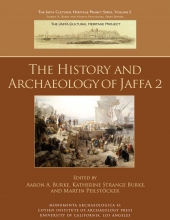Gazeteer of Jaffa’s streets referenced in discussions of Jaffa’s history and archaeology.
Places, monuments, and institutions in Jaffa.
Notes
Locations are in the lower town unless otherwise indicated as on Tel Yafo. Current street address is indicated when possible. Sandel numbers refer to Theodor Sandel maps of 1878–1879: A = inset; B = Jaffa and surroundings (see Shacham 2011:fig. 13.19). Italics indicate items included in this appendix.
One of the main problems confronting researchers in Jaffa is the variability of spelling of place names, many relatively modern, which occur in scientific literature. The problem begins with the site’s name, which varies from period to period and by language between periods. While some of these names appear frequently among publications, such as Hadashot Arkheologiyot—Excavations and Surveys in Israel, variations in spellings throughout different publications complicate accessing Jaffa’s many published excavations and clarity concerning toponyms and monument names. Owing to English being the chosen language for publication of the JCHP series and, likewise, for the sake of consistency, the editors have employed “Jaffa” rather than Yafo (Hebrew pronunciation) or Yafa (Arabic pronunciation).
Since the identification of Jaffa’s archaeological mound (a proper tell), often referred to as “Tel Yafo,” is a modern phenomenon—associated with Operation Anchor in 1936 (Gavish 2013) and only employed in Hebrew thereafter—this term is now widely used to refer to the mound itself. There is a legal basis for this as well, namely, that Tel Yafo under the Law of Antiquities is classified as Zone 1 and under the strictest policies, which restrict new construction and thus limit archaeological work almost exclusively to research excavations (see Ajami 2011:p. 33, and fig. 3.1). As a result of the traditional distinctions possible between tell settlement and settled areas adjacent to the tell, whether extramural on the tell’s slopes or below the tell, it is possible to speak of archaeological remains of the upper town (i.e., Tel Yafo) and the lower town (i.e., off the tell) during various periods (e.g., Chapter 3). Most places and monuments listed in these tables are situated in Jaffa’s lower town, off the mound of Tel Yafo.
Technical Notes
Above is a list of the preferred English names and spellings for both streets (Table 0.1) and places, monuments, and institutions (Table 0.2) within Jaffa employed in JCHP publications. These lists, while not exhaustive, update and replace the first published version that was included in HAJ 1 (Burke and Peilstöcker 2011). Descriptions of the locations and equivalent terms are provided whenever possible. Italics are employed for terms appearing elsewhere among these entries. For the alphabetizing of street names, the titles of individuals (e.g., Rabbi) and first names are ignored; however, note that in some cases, preceding elements are part of the name (e.g., Ben Dosa). Note, also, the handling of the definite article for street names, which is not considered in English alphabetizing.
Maps online provide locations of most of these streets, so a comprehensive map is not provided here. More detailed information concerning institutions and locations of features within Jaffa appears in a number of publications. For excavation areas, see Peilstöcker (2011); for nineteenth-century Ottoman Jaffa, see Kark (1990:64–65, 67–68). See also maps from 1799 to 1948 in Shacham (2011). For the excavations conducted in each area, consult Appendix 2 in this volume and Peilstöcker (2011:table 2.9). Cross-references are made in the description to the 1878–1879 Baedeker guidebook map (B) and its inset (A) produced by Theodor Sandel.
Works Cited
Ajami, Moshe
2011 Cultural Heritage Management: The Flea Market and Clock Tower Square Excavations. In The History and Archaeology of Jaffa 1, edited by Martin Peilstöcker and Aaron A. Burke, pp. 33–40. The Jaffa Cultural Heritage Project 1. Monumenta Archaeologica 26, Aaron A. Burke and Martin Peilstöcker, eds., Cotsen Institute of Archaeology, Los Angeles.
Burke, Aaron A., and Martin Peilstöcker
2011 Appendix: Terminology for Excavation Areas and Regions within Jaffa. In The History and Archaeology of Jaffa 1, edited by Martin Peilstöcker and Aaron A. Burke, pp. 291–292. The Jaffa Cultural Heritage Project 1. Monumeta Archaeologica 26, Aaron A. Burke and Martin Peilstöcker, eds., Cotsen Institute of Archaeology, Los Angeles.
Gavish, Dov
2013 „Operation Anker“: die Zerstörung Jaffas 1936. In Jaffa: Tor zum Heiligen Land, edited by M. Peilstöcker, J. Schefzyk, and A. A. Burke, pp. 146–150. Nünnerich-Asmus, Mainz.
Kark, Ruth
1990 Jaffa: A City in Evolution (1799–1917). Translated by G. Brand. Yad Izhak Ben-Zvi, Jerusalem.
Peilstöcker, Martin
2011 The History of Archaeological Research at Jaffa, 1948–2009. In The History and Archaeology of Jaffa 1, edited by Martin Peilstöcker and Aaron A. Burke, pp. 17–32. The Jaffa Cultural Heritage Project 1. Monumenta Archaeologica 26, Aaron A. Burke and Martin Peilstöcker, eds., Cotsen Institute of Archaeology, Los Angeles.
Shacham, Tzvi
2011 Jaffa in Historical Maps (1799–1948). In The History and Archaeology of Jaffa 1, edited by Martin Peilstöcker and Aaron A. Burke, pp. 137–174. The Jaffa Cultural Heritage Project 1. Monumenta Archaeologica 26, Aaron A. Burke and Martin Peilstöcker, eds., Cotsen Institute of Archaeology, Los Angeles.
Item record
Reuse
Burke, Aaron A., Katherine Strange Burke, and Martin Peilstöcker 2017. "Appendix 1: A Gazetteer for Jaffa: Excavation Areas, Places, and Historical Monuments" for The History and Archaeology of Jaffa 2. Version 1. Cotsen Institute of Archaeology Press. https://doi.org/10.25346/S6/C3TRD7
